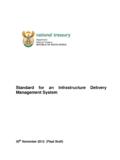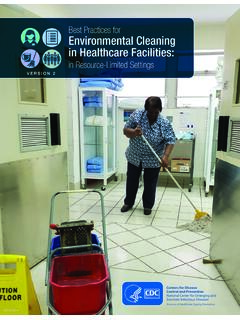Transcription of Appendix 3 - Risk Management Plan Risk Register
1 Page 1 of 35 Appendix 3 Risk Management Plan & Risk Register Contents 1. Introduction Page 1 2. The Council s Risk Management Strategy Page 1 3. Risk Management for the LUF Scheme Page 3 4. procurement and Contract Management Page 4 5. Contingencies and Risk Page 5 6. procurement and Contract Management Page 5 Appendix A High Level Risk Register Page 9 Appendix B Risk Management Policy Statement & Strategy Page 13 1. Introduction Improvements, included in the package of regeneration and transport projects for this bid, are focused on Kempston town centre. The scheme has an overall aim of improving the economic vitality of Kempston. This risk Management plan sets out financial and other risks and how they will be mitigated. It explains the principles relating to the Council s risk Management strategy and the approach to be taken with respect to this scheme.
2 It also covers refers to the project Management , governance, stakeholder engagement and communication, procurement and contract Management . 2. The Council s Risk Management Strategy Scheme risks will be managed in accordance with the Council s Risk Management Strategy, included at Appendix B of this document. The Project Manager will be responsible for the Management of risks associated with the scheme, including chairing regular risk workshops and maintaining the Risk Register . The risk Management process improves when responsibility for individual risks are delegated to team members, where necessary. Therefore, risk workshops will be held at regular intervals during the delivery of the scheme and will be timed to coincide with various key milestones and activities shown on the programme. Start of detailed design for scheme elements Midpoint of detailed design for scheme elements Start of procurement for individual scheme elements Following award of contract for individual scheme elements During mobilisation period At frequent intervals during construction period.
3 The Project Manager will re-issue the Risk Register as and when it is revised. Membership of the risk workshops will vary depending upon the stage of the project. The effective Management of risk and uncertainty through accurate evaluation and proactive mitigation of risks is critical to the success of the project. The following guiding principles will be adhered to: Page 2 of 35 Risk Management is part of all project Management board meetings and decision-making scheme risk will be managed as an on-going process as part of the scheme governance structure. A scheme risk Register is maintained and updated at each of the two-weekly Project Governance Board meetings. Responsibility for the risk Register being maintained is held by the Council s Project Manager. Risk Management will be proactively and consistently applied throughout the scheme lifecycle Risk communication will be open and transparent to all stakeholders The Management of risks is to ensure their reduction to a level as low as reasonably practical' or adopt appropriate mitigation strategy.
4 A risk assessment will be initiated at the beginning of the project, with the identification and assessment of risks in terms of their likelihood and associated cost outcomes, and follows a cyclical process as shown below. The risk assessment will be reviewed regularly and the Scheme Steering Group & Board will identify risks and measure their impacts on the programme. All risks will be documented in a Register with the impact on programme clearly defined and the mitigation set out. The programme will take account of the most likely scenario after mitigation. The first step is the identification of all risks affecting the project through risk workshops and risk reviews, resulting in a risk Register . Risk workshops typically include a mixture of expertise such as engineers, designers, finance officers, procurement specialists, and environmentalists.
5 Typically, the risk Register is instigated with a list of project risks with qualitative information, then through various workshops and iterations, it will be developed to a comprehensive risk Register to log the full spectrum of potential risks (also Page 3 of 35 opportunities if necessary). Appropriate risk owners will be allocated for each risk, and progress on the Management of the key risks will be discussed at each Project Board meeting. Periodic risk workshops will review all risks, add new risks, and close expired risks as the project progresses. The second step of the process is the analysis of the various risks by defining their distributions in terms of probabilities, impacts and knock-on effects. This information is gathered through risk workshops and other interactions. A qualitative risk ranking will be undertaken in the form of a standard decision matrix using the concept shown below.
6 Each risk will be assessed using a score (as set out below) for Cost, Time, Performance, and Probability to calculate an overall risk scoring and to categorise into Red, Amber, Yellow or Green. (The Risk Management Strategy, at Appendix B of this document, provides the basis for scoring risks.) 3. Risk Management for the LUF Scheme The initial high level Risk Register can be found at Appendix A of this document. This has identified 29 risks, which are scored at minor or insignificant, having taken account of planned mitigation measures. The was carried out by using the scoring grid, as above (likelihood and impact), and the guidelines on page 30 (in the appended Risk Management Strategy). Each risk in the Risk Register lists the potential impact/consequences, risk assessment and the actions to be undertaken, in an effort to mitigate the residual risk.
7 An important aspect of the Management process is identifying risks associated with scheme delivery and funding early in the process to allow mitigation to be identified. In order to avoid extreme consequences, this risk Management strategy would be Page 4 of 35 followed throughout the project and would reduce the risk level of these uncertainties. Should this scheme come forward there will be interdependencies that will need to be managed, particularly in relation to procurement and availability of contractors, requirements for design resource and timetabling of works so that appropriate diversionary routes are available when the highway improvements are under construction. These interdependencies have been considered in the Risk Register . Project risk will be managed as an ongoing process as part of the scheme governance structure, as set out in the delivery Plan at Appendix 2 of the bid application form.
8 A more detailed scheme risk Register will be established and will be reviewed as a standing item at each Project Board meeting. Responsibility for the risk Register being maintained is held by the Council s Project Manager in conjunction with the Project Steering Group and is reported to the Project Board in the form of checkpoint reports. Any high residual impact risks are then identified on the highlight report for discussion at the Scheme Board meeting. Required mitigation measures are discussed and agreed at the meeting and actioned by the Project Manager and Steering Group as appropriate. Other constraints such as the requirement for planning permission or railway possessions have been included in the risk Register . The experience of Council staff is highlighted in terms of delivering major schemes effectively and with little adverse effect.
9 In order to achieve successful delivery of major schemes, Management policies, processes and procedures are required to be followed accurately. An important aspect of the Management process is identifying risks associated with scheme delivery and funding early in the process to allow mitigation to be identified. 4. procurement and Contract Management Once funding has been awarded, procurement relating to all external elements of the programme will be undertaken in accordance with Bedford Borough Council s procurement Strategy, to ensure we achieve best value for money and quality of service. Details of our approach to procurement (including our procurement Strategy and Contract Procedure Rules) can be viewed at: Risk workshops will be held prior to each design, procurement , mobilisation and construction stage as identified in the delivery Plan (at Appendix 2 of the bid application form).
10 Risks that are best managed by the contractor will be allocated to be priced by the contractor accordingly. Risks best managed by the Council will be retained, so will be excluded from the contract(s). A series of risk workshops will be undertaken over the course of the project, with results compiled into the Risk Register . Risks are assessed on their likelihood and their severity, both with and without mitigation. The Council will meet with external contractors on a monthly basis throughout the Page 5 of 35 construction and delivery periods on each individual Scheme, or more frequently if this is deemed necessary by the Project Manager. All contractors will be contractually obliged to provide monthly progress and financial updates to the Council, which will include updates to the project programme. If delays are expected due to residual risks occurring, the Project Manager will consult the Steering Group and agree upon the best course of action.






